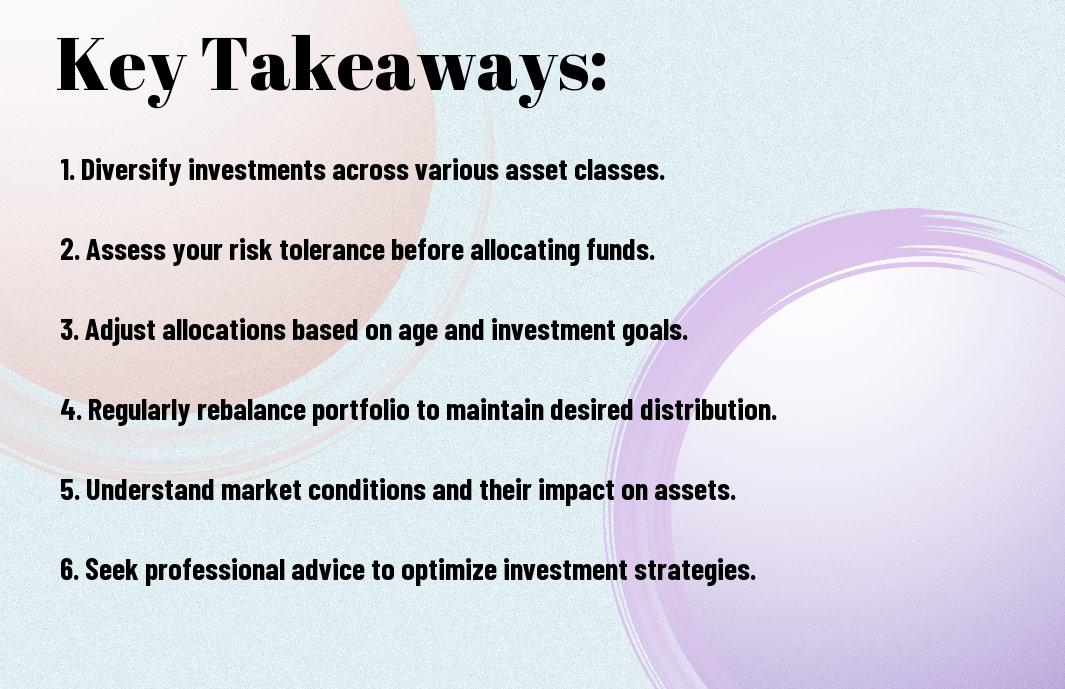Allocation of your investment assets is a foundational step in building a successful portfolio. By understanding how to effectively distribute your assets among various investment categories like stocks, bonds, and cash, you can enhance your potential for long-term growth while managing risk. This guide will walk you through the key principles of asset allocation, tailored for beginners, so you can make informed decisions that align with your financial goals and risk tolerance.
Key Takeaways:
- Definition: Asset allocation involves distributing investments across various asset classes to achieve a desired risk-reward balance.
- Risk Tolerance: Understanding your risk tolerance is necessary in determining the right mix of assets for your investment portfolio.
- Diversification: Allocating investments among different asset types can help mitigate risk and enhance potential returns.
- Time Horizon: Your investment time frame influences asset allocation; longer horizons may allow for more aggressive investments.
- Periodic Reviews: Regularly reassessing your asset allocation is important to ensure it aligns with your financial goals and changing market conditions.


Understanding Asset Allocation
For anyone begining on their investment journey, understanding asset allocation is fundamental. It refers to the strategy of diversifying your investment portfolio across various asset classes to balance risk and reward. By allocating your assets wisely, you can optimize your investment returns based on your financial goals, risk tolerance, and investment timeline.
Definition and Importance
Asset allocation is the process of dividing your investment portfolio among different asset categories, such as stocks, bonds, and cash. It plays an important role in managing risk and achieving financial goals by reducing the impact of market volatility on your overall portfolio performance.
Common Asset Classes
An understanding of common asset classes is important for crafting a balanced investment portfolio. The major asset classes include equities (stocks), fixed income (bonds), cash or cash equivalents, and alternative investments such as real estate and commodities. Each class has distinct characteristics, risks, and potential for returns, so familiarizing yourself with them will help in making informed investment decisions.
To further explore common asset classes, consider how equities typically offer higher potential returns but come with increased volatility. Fixed income investments, like bonds, usually provide more stable income but lower returns. Cash equivalents, such as money market funds, offer liquidity and preservation of capital but yield minimal interest. Finally, alternative investments can diversify your portfolio and hedge against inflation, though they often require more expertise to manage effectively. By understanding each class, you can create a tailored asset allocation strategy that aligns with your financial objectives.
Factors Influencing Asset Allocation
Assuming you are ready to investigate the world of investing, several factors will shape your asset allocation strategy. Understanding these influences can help you create a balanced portfolio that aligns with your financial objectives. Consider the following:
- Your risk tolerance
- Your investment goals
- Your time horizon
- Your market conditions
- Your financial situation
This awareness will empower you to make informed decisions as you navigate your investment journey.
Risk Tolerance
Along your investment journey, assessing your risk tolerance is vital. This personal metric reflects how much market volatility you can withstand without feeling uncomfortable. It varies from person to person and is influenced by factors like age, income, and investment experience. Knowing your risk tolerance will help you determine the right mix of assets for your portfolio.
Investment Goals
Across your investing endeavors, defining clear investment goals is necessary for effective asset allocation. These objectives can range from saving for retirement to purchasing a home or funding a child’s education. Each goal comes with its unique timeline and financial requirements, guiding you in selecting suitable investments that align with your aspirations.
Factors influencing your investment goals establish the roadmap for your portfolio. Short-term goals may necessitate more conservative investments, while long-term objectives may allow for a higher risk appetite to maximize growth potential. Align your asset allocation with both the time frame and the level of risk you are willing to undertake for each goal to enhance your chance of success.
The Asset Allocation Process
Unlike investing in individual stocks, asset allocation involves spreading your investments across different asset classes to manage risk and enhance returns. This process requires you to understand your financial goals, risk tolerance, and investment time horizon. For detailed guidance, explore Finding the Right Asset Allocation.
Assessing Your Financial Situation
Below, you will need to evaluate your current financial health, including your income, expenses, debts, and existing investments. Taking stock of these elements helps you identify how much you can invest and the level of risk you can comfortably handle.
Developing an Asset Allocation Strategy
Between understanding your financial situation and creating an effective investment plan, developing an asset allocation strategy is vital. It involves deciding the percentage of your portfolio to dedicate to various assets like stocks, bonds, and cash equivalents.
For instance, if you are younger and have a longer investment horizon, you might opt for a higher allocation in stocks, which can offer greater growth potential. As you approach retirement, you may shift toward more conservative investments, such as bonds, to preserve your capital. Tailoring your strategy to your financial goals and time frame is vital for effective asset management.
Diversification: A Key Principle
Your investment portfolio should reflect the principle of diversification, which involves spreading your investments across various asset classes. This strategy helps to mitigate risk; when one asset performs poorly, others can compensate, ultimately stabilizing your returns. By adopting a diversified approach, you safeguard your financial future and enhance your potential for growth.
Benefits of Diversification
Along with reducing risk, diversification can lead to more stable returns over time. By investing in different sectors or asset types, you can protect yourself from market volatility. This balanced approach not only helps in preserving your capital but also improves your opportunities for consistent long-term gains.
Strategies for Achieving Diversification
Between stocks, bonds, real estate, and other assets, you can create a well-rounded portfolio that aligns with your risk tolerance and investment goals. Diversification can also extend to geographic regions and investment styles, providing further layers of safety and growth potential.
In fact, you can achieve diversification by selecting a mix of asset classes that cater to your individual financial situation. Consider allocating your capital across domestic and international markets, various industries, and even including alternative investments like commodities or real estate. Additionally, utilizing index funds or exchange-traded funds (ETFs) can simplify this process, giving you exposure to a broad array of securities in one investment. This strategic blending not only reduces risk but also maximizes your return potential over time.
Rebalancing Your Portfolio
To maintain the desired risk level and asset allocation in your portfolio, regular rebalancing is vital. This involves periodically assessing your investments and making adjustments to return to your target allocation. Market fluctuations can cause your portfolio to drift from its original setup, so rebalancing helps ensure that you stay aligned with your investment goals and risk appetite.
When and How to Rebalance
When you notice that your asset allocation has deviated significantly from your original plan—typically by 5% or more for any given asset class—it’s time to consider rebalancing. You can do this on a set schedule, such as annually or semi-annually, or reactively, responding to market changes. The process typically involves selling overperforming assets and purchasing underperforming ones to restore your target allocation.
Tools for Effective Rebalancing
Above all, various financial tools and platforms can assist you in monitoring and rebalancing your portfolio effectively. Many brokerages offer built-in rebalancing features, which automatically alert you when your portfolio drifts from its target allocation, making the process seamless.
Indeed, utilizing portfolio management tools can enhance your rebalancing strategy significantly. These tools often provide insights into performance metrics, risk exposure, and market trends, allowing you to make informed decisions. Popular options include online brokerage platforms, robo-advisors, or dedicated financial software that helps you track your allocation in real-time. By leveraging these resources, you can simplify the rebalancing process and stay focused on achieving your long-term financial objectives.
Common Asset Allocation Models
Keep in mind that various asset allocation models can help guide your investment decisions and align them with your financial goals. Understanding these models will allow you to create a diversified portfolio that reflects your risk tolerance and investment timeline, leading you toward achieving your objectives effectively.
Age-Based Strategies
Between your ages and investment horizons, age-based strategies often suggest a higher allocation to equities when you are younger due to a longer time frame to recover from market volatility. As you age, the model typically shifts towards fixed income and other conservative investments to preserve capital, ensuring financial stability as you approach retirement.
Risk-Based Models
Around your comfort level with risk, risk-based models categorize investors into distinct profiles—conservative, moderate, and aggressive. This allows you to choose an asset allocation that suits your risk appetite while balancing the potential for returns.
RiskBased models take into account your willingness and ability to endure market fluctuations. For instance, if you’re classified as a conservative investor, your portfolio may focus heavily on bonds and cash equivalents, prioritizing capital preservation. In contrast, an aggressive investor would lean towards equities and alternative investments, seeking higher returns despite the higher volatility. By aligning your portfolio with your risk profile, you enhance your chances of achieving your long-term financial objectives while maintaining peace of mind in the ever-changing market landscape.
Conclusion
From above, you have learned the fundamentals of asset allocation and how it can impact your investment portfolio. By diversifying your investments across various asset classes, you can better align with your financial goals and risk tolerance. For more insights on enhancing your investment strategy, consider checking out Understanding Asset Allocation and its Potential Benefits. This knowledge empowers you to make informed decisions that can lead to more effective wealth management.
FAQ
Q: What is asset allocation and why is it important for beginners?
A: Asset allocation is the process of dividing your investment portfolio among different asset categories, such as stocks, bonds, and cash. This strategy helps manage risk and optimize returns based on your financial goals and risk tolerance. For beginners, understanding asset allocation is vital because it provides a framework to make informed investment choices and to create a diversified portfolio that can withstand market fluctuations.
Q: How can I determine the right asset allocation for my investment goals?
A: To determine the right asset allocation, consider your investment goals, time horizon, and risk tolerance. Evaluate how soon you need to access your funds—if it’s many years away, you might lean towards a more aggressive allocation with higher equity exposure. Conversely, if your goals are short-term, a conservative approach with more bonds and cash may be prudent. Various online calculators and questionnaires can also help guide this process, offering personalized recommendations based on your inputs.
Q: How often should I review and adjust my asset allocation?
A: It’s advisable to review your asset allocation at least once a year or following significant life events, such as a job change, marriage, or having children. Regular reviews allow you to assess whether your allocation remains aligned with your goals and risk tolerance. If market conditions significantly alter the balance of your portfolio, or if you find that your investment priorities have changed, consider rebalancing your assets to maintain your targeted allocation.






